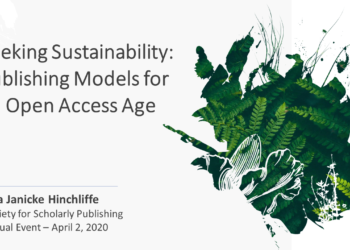Today’s post continues the exploration of Subscribe to Open (S2O) as an open access business model from yesterday’s Part One.
Voices included here are: Curtis Brundy (Associate University Librarian, Iowa State University), Larry Howell (Professor of Mechanical Engineering and Associate Academic Vice President, Brigham Young University), Judith Russell (Dean of University Libraries, University of Florida), Rick Anderson (University Librarian at Brigham Young University and Scholarly Kitchen Chef), Tom Ward (Professor of Mathematics and Pro-Vice Chancellor (Education), Newcastle University), Richard Gallagher (President and Editor-in-Chief, Annual Reviews), Michael Levine-Clark (Dean of the University of Denver Libraries)

Q: In particular, is S2O sustainable in a global setting, given the wide variances in definitions of and support for open access (OA) across different geographic regions?
Curtis Brundy:
Subscriptions worked across different geographic regions. So the underlying fundamentals are in place. This is actually a competitive advantage to S2O compared to article processing charge (APC) based open access models that require changes to publishing platforms, publisher workflows, and library workflows. To the extent OA definitions and support are an issue, I think that would equally apply to all OA models. But again, S2O has an advantage since it provides a fairly seamless transition from traditional subscriptions.
Larry Howell:
It seems unlikely to be sustainable. You mention the wide variances in definitions of OA. The proliferation of OA models has the potential of further muddying the OA waters. For university administrators who deal with diverse sets of issues across campus, it is hard to take the time to grasp the nuances of the different OA models. As these different models are proposed, it may make it increasingly difficult for library administrators to convey the value of different approaches to university administrators.
Judith Russell:
This is perhaps the trickiest part and not likely to be overcome quickly or easily. There are already significant differences between European and US policy and practice. The Coalition S and similar centralized agreements with European countries are not possible in the US without a major change in federal financial and policy support, which is unlikely in the near term. Unfunded mandates for deposit of author manuscripts for federally-funded research undermine the movement toward true open access publishing in journals.
Tom Ward:
Possibly, but this feels challenging. I can see several different challenges. S2O may fall in or out of compliance with emerging regulatory mandates on OA. A collective approach to subscription pricing sensitive to shifting economic power of various sorts would be tricky. Is, for example, a poorly-funded university (and hence library) system in a wealthy country more deserving of subsidy than a library system in a less wealthy country?
Rick Anderson:
I don’t think it’s as simple as saying that S2O itself either “is” or “isn’t” sustainable globally. I think what we’ll find is that, just like every other publishing model, S2O works quite well for some and doesn’t work at all well for others. For example, a large and diversified publisher with robust and diverse revenue streams will be more likely to succeed with the S2O model; even if its S2O program fails to achieve net revenues itself, it may be useful on balance as a loss-leading program that attracts prestigious authors and as an OA program that creates a halo effect for the publisher in the scholarly community. On the other hand, S2O is likely to work less well for a smaller and more specialized publisher that relies heavily on subscription revenues to keep the lights on. For new publishers, especially in less richly resourced regions of the globe, I don’t think S2O is at all promising as an initial business model.
Richard Gallagher:
I can’t speak to that wide variation because we generally encounter support across the world for the idea that all institutions of learning have a role in making knowledge available to the wider community. Participation across all geographic regions in the conversion to open is a crucial step in creating a more equitable academic publishing ecosystem, and S2O is one way of enabling this. In a real sense, the subscribing institution is making the content available to their local community, and this is something we intend to indicate to readers.
Michael Levine-Clark:
In regions with no central support for OA, it will fall on universities to fund S2O. Many of us have large collections budgets and flexibility to choose what to subscribe to. We often do not have funding to support open access (or have very limited funds), so S2O’s designation as a subscription coming from the collections budget helps in some way. However, if we compare it to other subscriptions, it can seem less urgent (since it’s openly available), so for long-term sustainability it seems important to build dedicated OA funding.
The fact that S2O is based on annual subscription results means that a journal can flip from open to paywall to open over time. For an author who is required by a funder to publish OA, what happens when they publish an article in a S2O journal that does not meet the funding requirement that year and their article remains behind a paywall? Does the risk of publishing in this environment make authors less likely to submit?
Q: Will university administrators support S2O as a long-term approach to open publishing?
Curtis Brundy:
The value proposition for S2O is strong. I have no reason to believe university administrators will not understand this. In fact, the only scenario I can foresee where S2O would lose a university administrator’s support is because the library at that institution does not support it. But evidence so far suggests libraries are very interested in the model. So I don’t believe this scenario will be common.
Larry Howell:
It seems unlikely to see support in the long run for the reasons above.
Judith Russell:
Right now, the decision rests with me and is affordable within my materials budget without seeking approval from university administration. It would take extremely strong support from the faculty, especially the other deans, if the costs increase to the point where I need to seek funding/approval to continue S2O as part of the library materials budget.
Tom Ward:
My fear would be that they might in the short term, but would be hard pressed to be able to genuinely lock in the long-term commitments needed. Librarians will remain exposed to budget pressures on one hand, and subscription inflation on the other. Perverse incentives crop up in multiple places. It is tempting to see the model as attractive because it reduces direct payments of APCs and so on – but in some cases those are funded by external bodies, so the library itself would see no saving.
Rick Anderson:
Very short answer: no. Medium-length answer: well, it depends. Long answer: only to the degree that the university administrators in question are explicitly dedicated to the missions and goals of the OA movement. And in my experience, there are relatively few such administrators (though they do exist). Unless university administrators are explicitly dedicated to supporting OA, it’s difficult to see how supporting S2O can possibly make sense to them, in light of all the other demands being made on the resources they are charged with marshalling. Again, there’s an absolutely stubborn reality at work here when you’re managing a budget: every dollar you spend on A thereby becomes unavailable to spend on B. And that means the administrator can’t just ask herself “Is S2O a good thing to support?”. She also has to ask herself “Is supporting S2O the best way I can use this money?”. And the answer to that question won’t always be “yes.”
Richard Gallagher:
I have high hopes that they will. The most important factor is a person’s attitude to OA in general, which shapes their attitude to S2O. Among the (admittedly few) administrators that I have spoken with, S2O has been as well received as it is among researchers and librarians. They understand that S2O presents the choice of subscribing to open or to gated access because free riding will default to a paywall model.
Michael Levine-Clark:
One of the challenges of S2O is that it relies on all subscribers – whether they publish in the journals or not – to maintain subscriptions, but many subscribers (even at research institutions) may be primarily or entirely readers of these particular journals. It is easier to make the case to university administration to support projects that help authors from the university publish than for the broader cause of converting journals to open.
Every year, library leaders meet with the provost and/or other budget officers for the university and make a case for funding. Every year there’s a request for additional funds to cover the increasing costs of journal subscriptions. Most years that request is not granted even though it is clear that the result will be cancellation of some journal subscriptions that matter to the faculty. In that context, it would be hard to ask for additional funding for something that would likely be available to the university even without participation in S2O.
Q: Are there metrics that administrators and librarians would wish to see when considering renewing an S2O agreement? What would those metrics be?
Curtis Brundy:
- Local, regional, global reading
- Local, regional, global publishing
- Perhaps to include reading and publishing from low- and middle-income countries and/or underserved institutions and groups
- Transparent pricing, including information utilizing a transparency framework such as from the Fair Open Access Alliance or cOAlition-S.
Larry Howell:
The metrics usually used to justify the cost of a subscription would still apply, but some additional metrics may be justified. For example, the temptation of cutting the journal in the long run may be overcome if their faculty regularly publish in the journal and there is demonstrable value to the university for the particular journal to be OA.
Judith Russell:
This is a very difficult question to answer. Without metrics in the Association of American Universities (AAU), US News, etc., that directly address the value of open access publishing by our authors, there is very little that would cause the university administration to allocate funding to the library for S2O. We are analyzing the expenditures for APCs across the university, though it is difficult to identify/track, and the ability to save on those expenditures by allocating money to the library is a possibility, but the sources of funds are so variable and widely distributed that it would be extremely difficult (perhaps impossible) to aggregate those funds for this purpose.
Tom Ward:
In addition to the usual measures like usage rates, things like maintenance and availability of back catalogue and stability would play a role. I can imagine a situation emerging where the biggest threat to stability comes from libraries requiring confidence about stability in order to renew. To add to the reading list of Olstrom’s book, the framers of S20 could watch “It’s a Wonderful Life”.
Rick Anderson:
It’s hard to say what metrics would be relevant, since in S2O the expenditure of money isn’t directly connected to the benefit of access to content. In other words, if you’re trying to measure the value of a traditional subscription, you can always look at metrics like cost per download. (Yes, that’s an imperfect metric, but it’s not a useless one — and it has the important benefit of direct relevance.) But if access isn’t connected to payment (if, in other words, you could stop paying and still get access), then what metrics will reveal how much value you’re getting in return for payment? Really, the decision to support S2O is more about realizing the institutional mission than anything else: “At our institution, we believe that supporting a shift to open access is important and we express that belief by underwriting OA publishing initiatives.” So I suppose one could measure the number of OA articles published per dollar of underwriting, or maybe the number of global downloads per published article, or — to be more institutionally specific — the number of articles published in the S2O journal by institutional authors. But those metrics only matter if they correspond to actual institutional goals.
Richard Gallagher:
COUNTER-type statistics to show that their subscriptions are meeting a need within their institutions will continue to be important metrics. I suspect that administrators and librarians will also be interested in usage within their community, their country, and perhaps in low- and middle-income countries. Financial transparency is increasingly seen as a requirement.
Michael Levine-Clark:
Administrators would most likely want to see information about publication by authors from the institution – both to see the volume of publication and the reach and impact of those publications. This would include new authors, potentially publishing with the expectation of OA, and authors whose older content becomes open. Librarians should be interested in those metrics as well as in usage statistics by the campus community (which is complicated because open content may be accessed in ways in which institutional affiliation isn’t evident). An S2O deal would need to demonstrate the same value, using the same metrics, that a standard subscription does (generally through COUNTER stats) as well as the value of any publishing that happens by university-affiliated authors.
Q: Should copyright/Creative Commons licensing considerations be separated completely from S2O as an open publishing model?
Curtis Brundy:
I think equitably opening content is the reason S2O exists. So S2O offers should meet community open expectations, including author retention of copyright and a CC BY license.
Larry Howell:
That’s a level of detail where I don’t feel I could give an informed opinion.
Judith Russell:
I have to confess that I have not given this enough thought to have a good answer to this question, but it is a question worth pursuing. My university is pursuing an author’s right policy which would have a similar result and believe it is appropriate. We have fairly broad faculty support.
Tom Ward:
I confess to being an academic whose eyes glaze over when I am asked to tick a box concerning a string of acronyms relating to subtle copyright issues. S2O at this stage needs to be about a big picture conceptual idea, and it could quickly lose focus if it sinks into a morass of acronyms. Many academics would like to see their work freely available to anyone interested, supported on stable platforms, and kept up to date in terms of access technologies.
Rick Anderson:
I would say yes, but it’s important to understand that I’m not someone who believes that CC BY (or the equivalent) should be considered an essential element of open access. The belief that it should be — that content isn’t really OA unless it’s not only freely available for all to read and download, but also available to reuse as if it were in the public domain — is essentially a religious position, one held by those whom we might characterize as OA fundamentalists. There are many others who fully support OA and also consider more restrictive licenses to be fully compatible with their position. But these aren’t disagreements about what is; they’re disagreements about what should be, and therefore aren’t really susceptible to strictly logical argumentation. Different people hold different beliefs about how the world should be, and that will always be the case.
Richard Gallagher:
Copyright and licensing are central issues for open access in general. We, and the other members of the S2O Community of Practice, aim to meet the widely agreed criteria on licensing.
Michael Levine-Clark:
It seems hard to separate these. It should be clear to subscribers up front what sort of copyright/Creative Commons rights there will be. Ultimately, it’s up to the author, their funder(s), and the publisher, but an institution might choose to support an S2O project (or not) based on the CC options.
Discussion
1 Thought on "Subscribe to Open (S2O): An Interview Post in Two Parts (Part 2)"
The truest measure of success in OA must be growing the globally diverse ouput of authorship and readership. Is this article published per institution? Per scholar? Article read per institution? Per patron? Only Curtis Bundy’s answer tackled this issue head on. So long as the discussion about OA models remains primarily an economic one, rather than an equity one, we are confined to a debate sure to exclude many voices.



